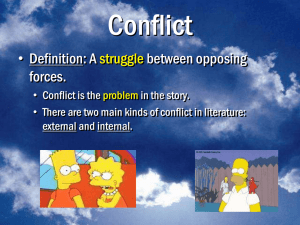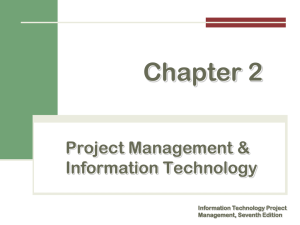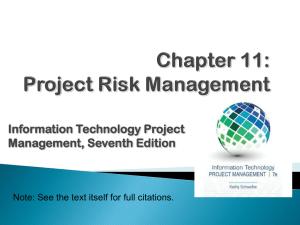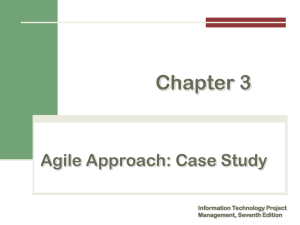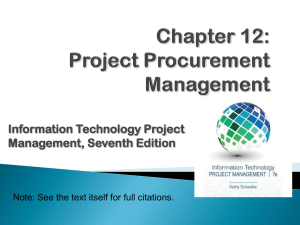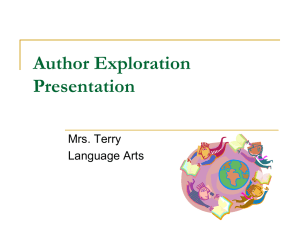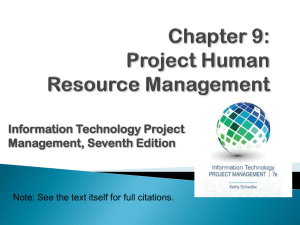Chapter 9 - e
advertisement
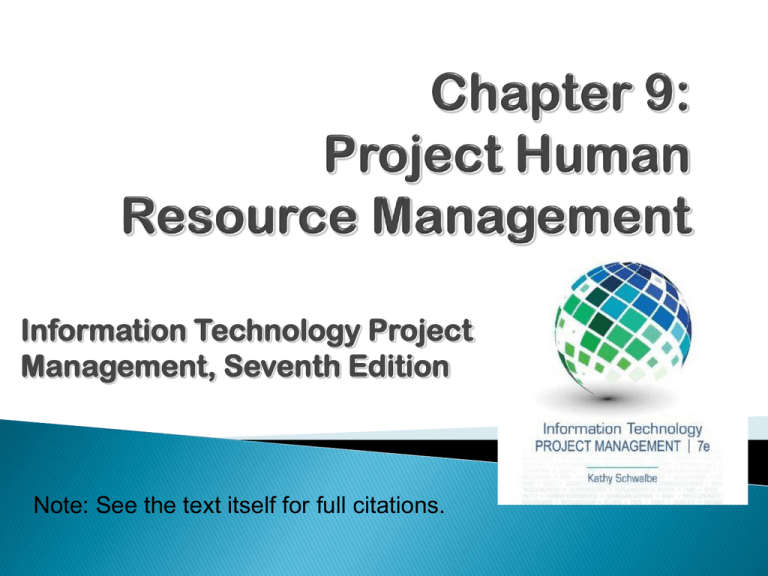
Information Technology Project Management, Seventh Edition Note: See the text itself for full citations. Explain the importance of good human resource management on projects, including the current state of the global IT workforce and future implications for it Define project human resource management and understand its processes Summarize key concepts for managing people by understanding the theories of Abraham Maslow, Frederick Herzberg, David McClelland, and Douglas McGregor on motivation, H. J. Thamhain and D. L. Wilemon on influencing workers, and Stephen Covey on how people and teams can become more effective Information Technology Project Management, Seventh Edition Copyright 2014 2 Discuss human resource management planning and be able to create a human resource plan, project organizational chart, responsibility assignment matrix, and resource histogram Understand important issues involved in project staff acquisition and explain the concepts of resource assignments, resource loading, and resource leveling Assist in team development with training, team-building activities, and reward systems Explain and apply several tools and techniques to help manage a project team and summarize general advice on managing teams Describe how project management software can assist in project human resource management Information Technology Project Management, Seventh Edition Copyright 2014 3 Many corporate executives have said, “People are our most important asset” People determine the success and failure of organizations and projects Information Technology Project Management, Seventh Edition Copyright 2014 4 Making the most effective use of the people involved with a project Processes include ◦ Planning human resource management: identifying and documenting project roles, responsibilities, and reporting relationships ◦ Acquiring the project team: getting the needed personnel assigned to and working on the project ◦ Developing the project team: building individual and group skills to enhance project performance ◦ Managing the project team: tracking team member performance, motivating team members, providing timely feedback, resolving issues and conflicts, and coordinating changes to help enhance project performance Information Technology Project Management, Seventh Edition Copyright 2014 5 Information Technology Project Management, Seventh Edition Copyright 2014 6 Psychologists and management theorists have devoted much research and thought to the field of managing people at work Important areas related to project management include ◦ motivation theories ◦ influence and power ◦ effectiveness Information Technology Project Management, Seventh Edition Copyright 2014 7 Intrinsic motivation causes people to participate in an activity for their own enjoyment Extrinsic motivation causes people to do something for a reward or to avoid a penalty For example, some children take piano lessons for intrinsic motivation (they enjoy it) while others take them for extrinsic motivation (to get a reward or avoid punishment) Information Technology Project Management, Seventh Edition Copyright 2014 8 Abraham Maslow argued that humans possess unique qualities that enable them to make independent choices, thus giving them control of their destiny Maslow developed a hierarchy of needs which states that people’s behaviors are guided or motivated by a sequence of needs Information Technology Project Management, Seventh Edition Copyright 2014 9 Information Technology Project Management, Seventh Edition Copyright 2014 10 Frederick Herzberg wrote several famous books and articles about worker motivation. He distinguished between ◦ motivational factors: achievement, recognition, the work itself, responsibility, advancement, and growth, which produce job satisfaction ◦ hygiene factors: cause dissatisfaction if not present, but do not motivate workers to do more. Examples include larger salaries, more supervision, and a more attractive work environment Information Technology Project Management, Seventh Edition Copyright 2014 11 Information Technology Project Management, Seventh Edition Copyright 2014 12 Specific needs are acquired or learned over time and shaped by life experiences, including: ◦ Achievement (nAch): Achievers like challenging projects with achievable goals and lots of feedback ◦ Affiliation (nAff): People with high nAff desire harmonious relationships and need to feel accepted by others, so managers should try to create a cooperative work environment for them ◦ Power: (nPow): People with a need for power desire either personal power (not good) or institutional power (good for the organization). Provide institutional power seekers with management opportunities Information Technology Project Management, Seventh Edition Copyright 2014 13 Douglas McGregor popularized the human relations approach to management in the 1960s Theory X: assumes workers dislike and avoid work, so managers must use coercion, threats and various control schemes to get workers to meet objectives Theory Y: assumes individuals consider work as natural as play or rest and enjoy the satisfaction of esteem and self-actualization needs Theory Z: introduced in 1981 by William Ouchi and is based on the Japanese approach to motivating workers, emphasizing trust, quality, collective decision making, and cultural values Information Technology Project Management, Seventh Edition Copyright 2014 14 1. Authority: the legitimate hierarchical right to issue orders 2. Assignment: the project manager's perceived ability to influence a worker's later work assignments 3. Budget: the project manager's perceived ability to authorize others' use of discretionary funds 4. Promotion: the ability to improve a worker's position 5. Money: the ability to increase a worker's pay and benefits Information Technology Project Management, Seventh Edition Copyright 2014 15 6. Penalty: the project manager's ability to cause punishment 7. Work challenge: the ability to assign work that capitalizes on a worker's enjoyment of doing a particular task 8. Expertise: the project manager's perceived special knowledge that others deem important 9. Friendship: the ability to establish friendly personal relationships between the project manager and others Information Technology Project Management, Seventh Edition Copyright 2014 16 Projects are more likely to succeed when project managers influence with ◦ expertise ◦ work challenge Projects are more likely to fail when project managers rely too heavily on ◦ authority ◦ money ◦ penalty Information Technology Project Management, Seventh Edition Copyright 2014 17 Power is the potential ability to influence behavior to get people to do things they would not otherwise do Types of power include ◦ ◦ ◦ ◦ ◦ Coercive Legitimate Expert Reward Referent Information Technology Project Management, Seventh Edition Copyright 2014 18 A responsibility assignment matrix (RAM) is a matrix that maps the work of the project as described in the WBS to the people responsible for performing the work as described in the OBS Can be created in different ways to meet unique project needs Information Technology Project Management, Seventh Edition Copyright 2014 19 Information Technology Project Management, Seventh Edition Copyright 2014 20 R = responsibility A = accountability, only one A per task C = consultation I = informed Note that some people reverse the definitions of responsible and accountable. Information Technology Project Management, Seventh Edition Copyright 2014 21 A staffing management plan describes when and how people will be added to and taken off the project team A resource histogram is a column chart that shows the number of resources assigned to a project over time Information Technology Project Management, Seventh Edition Copyright 2014 22 Acquiring qualified people for teams is crucial The project manager who is the smartest person on the team has done a poor job of recruiting! It’s important to assign the appropriate type and number of people to work on projects at the appropriate times Information Technology Project Management, Seventh Edition Copyright 2014 23 Staffing plans and good hiring procedures are important, as are incentives for recruiting and retention ◦ Some companies give their employees one dollar for every hour a new person they helped hire works ◦ Some organizations allow people to work from home as an incentive Enrollment in U.S. computer science and engineering programs has dropped almost in half since 2000, and onethird of U.S. workers were over the age of 50 by 2010 CIO’s researchers suggest that organizations rethink hiring practices and incentives to hire and retain IT talent Information Technology Project Management, Seventh Edition Copyright 2014 24 Resource leveling is a technique for resolving resource conflicts by delaying tasks The main purpose of resource leveling is to create a smoother distribution of resource usage and reduce overallocation Information Technology Project Management, Seventh Edition Copyright 2014 25 Information Technology Project Management, Seventh Edition Copyright 2014 26 When resources are used on a more constant basis, they require less management It may enable project managers to use a just-intime inventory type of policy for using subcontractors or other expensive resources It results in fewer problems for project personnel and accounting department It often improves morale Information Technology Project Management, Seventh Edition Copyright 2014 27 The main goal of team development is to help people work together more effectively to improve project performance It takes teamwork to successfully complete most projects Information Technology Project Management, Seventh Edition Copyright 2014 28 Forming Storming Norming Performing Adjourning Information Technology Project Management, Seventh Edition Copyright 2014 29 Training can help people understand themselves, each other, and how to work better in teams Team building activities include ◦ physical challenges ◦ psychological preference indicator tools Information Technology Project Management, Seventh Edition Copyright 2014 30 MBTI is a popular tool for determining personality preferences and helping teammates understand each other Four dimensions include: ◦ ◦ ◦ ◦ Extrovert/Introvert (E/I) Sensation/Intuition (S/N) Thinking/Feeling (T/F) Judgment/Perception (J/P) NTs or rationals are attracted to technology fields IT people vary most from the general population in not being extroverted or sensing Information Technology Project Management, Seventh Edition Copyright 2014 31 People are perceived as behaving primarily in one of four zones, based on their assertiveness and responsiveness: ◦ ◦ ◦ ◦ Drivers Expressives Analyticals Amiables People on opposite corners (drivers and amiables, analyticals and expressives) may have difficulties getting along Information Technology Project Management, Seventh Edition Copyright 2014 32 Information Technology Project Management, Seventh Edition Copyright 2014 33 1. Confrontation: Directly face a conflict using a problemsolving approach 2. Compromise: Use a give-and-take approach 3. Smoothing: De-emphasize areas of difference and emphasize areas of agreement 4. Forcing: The win-lose approach 5. Withdrawal: Retreat or withdraw from an actual or potential disagreement 6. Collaborating: Decision makers incorporate different viewpoints and insights to develop consensus and commitment Information Technology Project Management, Seventh Edition Copyright 2014 34 Information Technology Project Management, Seventh Edition Copyright 2014 35 Conflict often produces important results, such as new ideas, better alternatives, and motivation to work harder and more collaboratively Groupthink: Conformance to the values or ethical standards of a group. Groupthink can develop if there are no conflicting viewpoints Research suggests that task-related conflict often improves team performance, but emotional conflict often depresses team performance Information Technology Project Management, Seventh Edition Copyright 2014 36 Patrick Lencioni, author of several books on teams, says that “Teamwork remains the one sustainable competitive advantage that has been large untapped”* The five dysfunctions of teams are 1. 2. 3. 4. 5. Absence of trust Fear of conflict Lack of commitment Avoidance of accountability Inattention to results *Lencioni, Patrick, “Overcoming the Five Dysfunctions of a Team,” Jossey-Bass: San Francisco, CA (2005), p. 3. Information Technology Project Management, Seventh Edition Copyright 2014 37 Be patient and kind with your team Fix the problem instead of blaming people Establish regular, effective meetings Allow time for teams to go through the basic team-building stages Limit the size of work teams to three to seven members Information Technology Project Management, Seventh Edition Copyright 2014 38 Plan some social activities to help project team members and other stakeholders get to know each other better Stress team identity Nurture team members and encourage them to help each other Take additional actions to work with virtual team members Information Technology Project Management, Seventh Edition Copyright 2014 39 Project human resource management includes the processes required to make the most effective use of the people involved with a project Main processes include ◦ ◦ ◦ ◦ Plan human resource management Acquire project team Develop project team Manage project team Information Technology Project Management, Seventh Edition Copyright 2014 40

